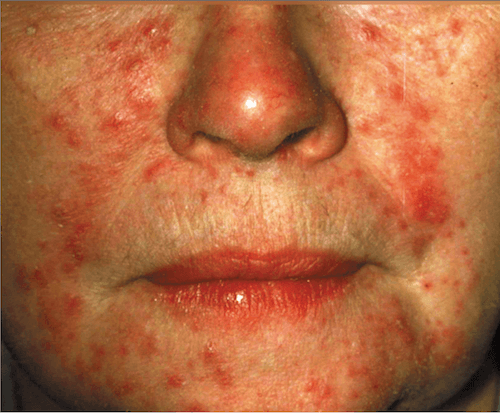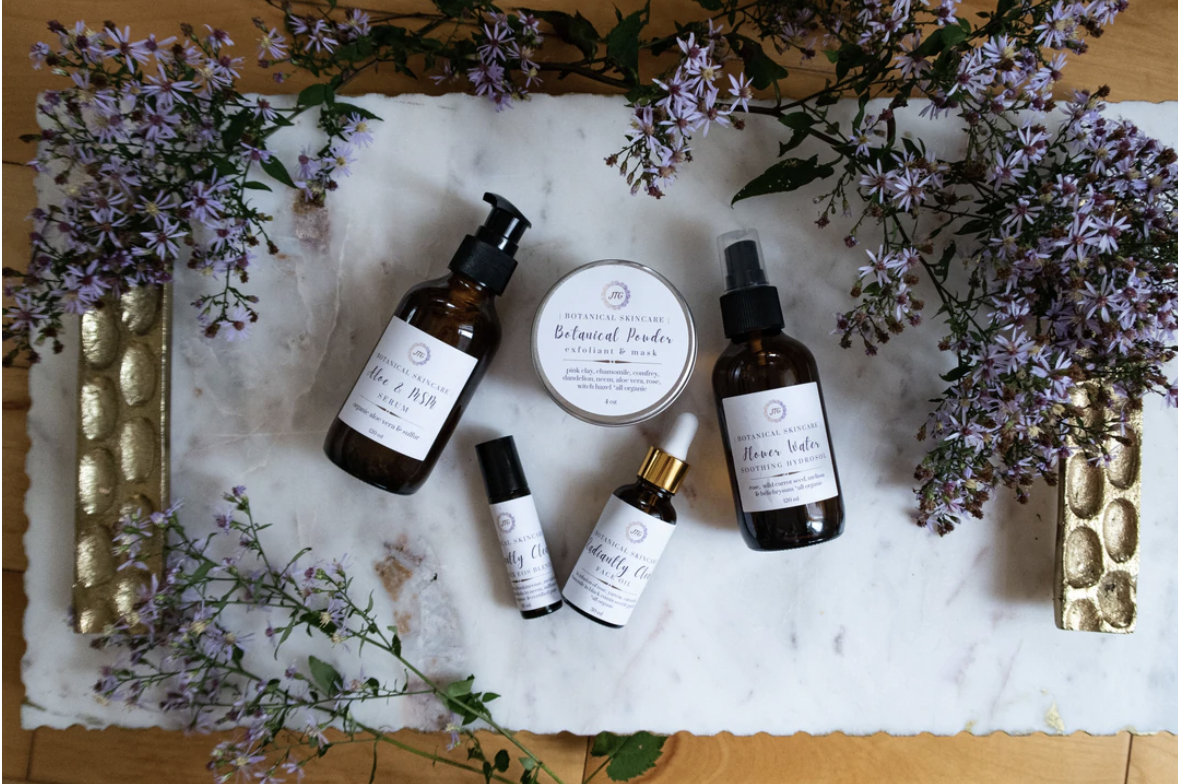Rosacea Demodex Mites
This blog post will dive into everything you need to know about natural solutions for Demodex mites and rosacea. Please scroll down for a video also on the topic.
What are Demodex mites?
Demodex mites are tiny, microscopic mites that are found on everyone’s skin. They’re a natural part of the human microbiome — the ecological community of microorganisms that live in and on the body.
There are two species of Demodex mites found in humans: Demodex folliculorum which lives in hair follicles, primarily on the face and in the meibomian glands of the eyelids, and Demodex brevis which live in the sebaceous glands of the skin.
Demodex folliculorum’s connection to rosacea may be linked to a distinct bacterium associated with the mites, called Bacillus oleronius.
If Demodex mites are naturally found on the skin microbiome, why are they a problem with rosacea?
The short answer is that the skin barrier in a rosacea patient is already damaged and inflamed so it takes very little to aggravate it further. (Ever react to a skincare product formulated for sensitive skin? Ever react to the sun? These are not “normal” reactions but a sign of severe inner and outer inflammation. A gift in disguise asking us to look deeper at what’s going on in the body.)
According to research, Demodex folliculorum are found on the skin of all humans but may occur in greater numbers in people with rosacea.
There’s been some debate whether the increased number of Demodex mites are the actual cause or result of rosacea. However, it appears that while an overabundance of Demodex may trigger an immune response in people with rosacea – or that inflammation may be caused by certain bacteria associated with the mites – there hasn’t been enough research to give us the data we need to draw conclusions.
From rosacea.org: “Rosacea is currently considered by most authors as a disease of the immune system, an inflammatory process including innate and then adaptive immune responses, which gets out of control resulting in vascular, inflammatory, and hypertrophic symptoms. While it likely induces immunotolerance, Demodex is also able to stimulate the immune system’s defense reaction [34, 43, 57, 58, 104, 110]. It stimulates Toll-like receptor 2 (TLR2) [58], resulting in an increased production of LL-37, with the subsequent angiogenesis and inflammation that are described in rosacea [15–18]. This implies the existence of a vicious circle including ETR, mite proliferation, and inflammation [10]. Demodex proliferation, therefore, seems to contribute to the continuum process in rosacea across all phenotypes.”
Does this mean you are forever at the mercy of Demodex mites if you have rosacea? Hell no! You can make your skin’s microbiome (aka the outer terrain) unfavorable to these little buggers with targeted botanical skincare and by working on healing the inner terrain (gut, liver, lymphatic + immune system).
Do I have Demodex mites if I have rosacea?
Not everyone with rosacea has an overabundance of Demodex mites. (You can exhale now.)

How do I know if I have Demodex mites?
You’ll know you have Demodex mites if you have red, blotchy breakouts every 3 weeks or so which is the living cycle of Demodex mites.
Sometimes these breakouts will appear in strange patterns like a zig-zag or will occur at the same spot on your face.
If you have rosacea, you may have Demodex mites if you feel an itching, crawling sensation on your face, scalp, or other parts of the body. Usually, this is felt at night which is when the mites are said to be more active. I’ve also heard clients say that their skin would itch midday or during a flare-up. This was the case for me when my rosacea was at its worst.
Another sign that you may have an overabundance of Demodex mites is enlarged pores. I shared in several podcast episodes that I was able to bring my pores back to “normal” with a blend of essential oils and a ph balancing hydrosol.
You may also see Demodex mites in pustular papular rosacea, where there are damaged capillaries and thickening of the skin.
Again, it has not been determined which comes first: the Demodex mites causing the initial inflammation or the Demodex being attracted/finding it easier to thrive on inflamed, rosacea skin. Personally, I’m suspecting the latter since the terrain has to be favorable to mites, otherwise they wouldn’t be at “home” there.
Photo from rosacea.org
Can I get a diagnosis of Demodex mites?
A definitive diagnosis of Demodex mites involves viewing an epilated eyelash under the microscope or scraping the skin. An ophthalmologist, dermatologist, or Naturopathic practitioner equipped with a good microscope would be able to do this for you.
Why it’s challenging to get rid of Demodex mites
Demodex mites spend most of their time hiding inside pores, are said to only come out at night to mate and then lay back inside sebaceous gland/follicles to lay their eggs. This is how rosacea patients get stuck in a cycle of constantly having mites proliferate and wreak havoc.
Please don’t be discouraged when reading this, plenty of people have treated Demodex mites and went on to live a happy life. 🙂
How to get rid of Demodex Mites and Rosacea
To get rid of Demodex mites in rosacea skin you’ll need patience, the right inner + outer treatment, and consistency. Plan to stay the course for at least 3 to 6 months.
For the “outer” treatment, I suggest using a natural skincare system that has been formulated with active plant botanicals that are antifungal, antibacterial, and anti-inflammatory. Look for carrier oils such as Black Cumin seed oil, Neem oil (doesn’t smell nice but it’s effective!), and essential oils such as Melaleuca (Tea tree), Frankincense, and Copaiba.
Please be VERY careful using essential oils on inflamed rosacea skin. Melaleuca in particular is extremely potent and can burn your skin. It took me ages to find the right balance, which you’ll find in the Radiantly Clear Demodex Rosacea System I created.
Sulfur creams have also been shown to help with Demodex mites but please read the label before purchasing. One particular brand made in China contains endocrine-disrupting ingredients and was reported to peel the outer layer of the epidermis. Not the strategy I’d use, quite frankly.
While it’s tempting to think that a skincare product will solve all your rosacea woes, it will not heal your skin. To fully heal rosacea, you need to address dysbiosis in the body.
Can you recommend a skincare line for Demodex mites and rosacea?
Yes, the Demodex Rosacea Skincare System I created called Radiantly Clear.
Tackling rosacea & Demodex mites from the inside-out
An inside-out approach to clear skin may involve:
• Healing the gut lining (leaky gut is a huge issue in rosacea patients)
• Making the terrain inhospitable for Demodex mites by lowering systemic inflammation and supporting your body’s overall health
• Supporting the liver’s detoxification process
• Looking at histamine intolerance, SIBO (small intestinal bacterial overgrowth), pathogens and viruses
• Eliminating inflammatory foods
• A targeted supplements protocol to treat dysbiosis and support the body’s healing process
• Addressing food sensitivities
• Optimizing sleep (crucial for hormonal balance and to allow the body to fully heal)
• Adopting a healthy stress response to life
• Releasing past traumas
• Exploring the emotional root cause of rosacea (key for many people)
As you investigate the root cause, you may need to invest in functional testing in order to pinpoint specifically what’s going on in the body. This is not the first place I start with clients as there are many areas that we can address before resorting to functional testing which can be expensive.
While you’re working with a Functional or Naturopathic practitioner, consider also supporting your body and skin health by ensuring that you have adequate levels of vitamins and minerals. Nutritional deficiencies will be identified and a protocol designed based on your bio-individuality when working with a Functional Nutrition Practitioner. So please wait before running to the health food store to splurge on supplements. A Functional Practitioner will also have access to high-quality supplements not sold in stores.
Vitamins and supplements that can support skin health:
• Vitamin A
• Vitamin D, E
• B vitamins
• Vitamin C (a building block for clear skin)
• Magnesium
• Zinc
• Selenium
• High-quality omega 3 fatty acids
• A probiotic can be a good idea to help restore the gut microbiome (assuming you’ve removed inflammatory foods in the first place) however since SIBO (small intestinal bacterial overgrowth) is present in a large number of rosacea patients, you’ll want to rule out SIBO before adding MORE bacteria to your gut microbiome or you’ll make things worst
• Supplements and targeted medicinal plants that heal the gut lining
Low stomach acid (low levels of HCL) is also an issue with a lot of rosacea patients, and addressing that can have an almost immediate effect on your skin.
Before we even look at healing gut dysbiosis, we need to optimize digestion via the stomach. I’ve seen so many people go through SIBO treatments (including myself) only to have the protocol fail because not enough focus was put on stomach acid.
There you have it, a natural, holistic and functional approach to treating Demodex mites and rosacea!

Radiantly Clear Botanical Skincare System for Rosacea
I created my own line of botanical skincare because I couldn’t find anything on the market that met my standards for clean beauty AND addressed the needs of sensitive, rosacea-prone skin.
The Radiantly Clear Rosacea / Demodex Botanical Skincare System contains 5 products, each formulated with pure plant botanicals that support the healing of inflamed rosacea-prone skin while making the skin’s microbiome (the terrain) unfavorable to Demodex mites.
Radiantly Clear Botanical Skincare System for Rosacea

I created my own line of botanical skincare because I couldn’t find anything on the market that met my standards for clean beauty AND addressed the needs of sensitive, rosacea-prone skin.
The Radiantly Clear Rosacea / Demodex Botanical Skincare System contains 5 products, each formulated with pure plant botanicals that support the healing of inflamed rosacea-prone skin while making the skin’s microbiome (the terrain) unfavorable to Demodex mites.
Rosacea Articles
Can you heal rosacea? Client success!
Can you heal rosacea? Client success! If you’ve ever felt frustrated or stuck in your journey to heal rosacea, I have something special for you. I recently sat down with Jessica, a client who’s completed my Vibrant & Radiant program. Her transformation is nothing...
Glow From Within: Best Supplements For Clear Skin (Especially Rosacea)
Glow From Within: Best Supplements for Clear Skin (Especially for Rosacea) When it comes to healing rosacea, what we put into our bodies is just as important as what we apply to our skin. If you’re dealing with rosacea, you know that redness, irritation, and flare-ups...
Rosacea skincare Demodex mites {Journey To Glow}
Rosacea Demodex Skincare Tips Live Zoom Community Call with Q&A Topics discussed in this video: Why I studied Functional Nutrition & Herbal Medicine for rosacea Why I created these products for Demodex mites (my personal journey) Brief overview of steps to...
{Video} Skincare Tips For A Rosacea Skin Crisis
Rosacea Skin Crisis Skincare Tips Live Zoom Community Call with Q&A I want to answer questions about the Radiantly Clear Rosacea / Demodex Skincare System and how to best use the products when your skin is in crisis. Please keep your questions coming, I will...
Exploring the Underlying Root Causes of Rosacea
Exploring the Underlying Root Causes of Rosacea In this blog post, we'll explore the underlying root causes of rosacea and the contributing factors that may lead to its development. Let's start with a better understanding of what is rosacea... Rosacea is characterized...
The Intricate Connection Between Liver Health and Rosacea
The Intricate Connection Between Liver Health and Rosacea Before we dive into the intricate connection between liver health and rosacea, let's take a look at how rosacea is defined by allopathic medicine. What is rosacea Rosacea, a chronic (but not incurable) skin...







